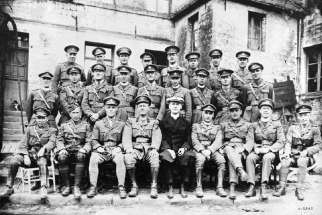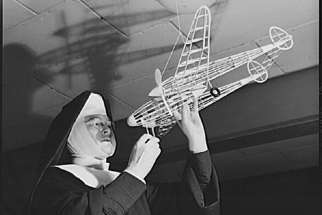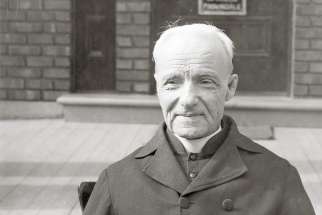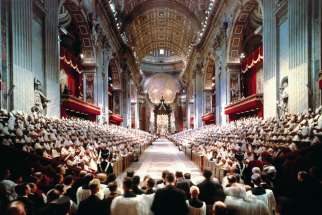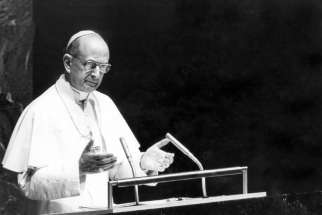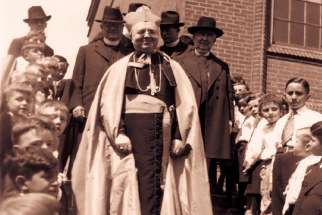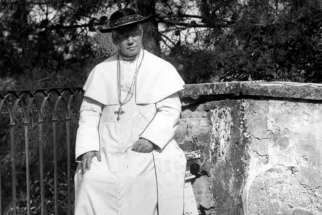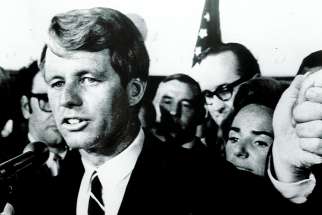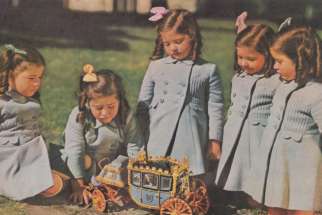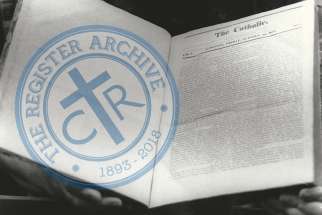The Register Archives: A glimpse of the faith, courage of Canada's WWI army chaplains
This year, Remembrance Day takes on an extra special aura, as Nov. 11 marks the 100th anniversary of the end of the First World War. Close to 61,000 Canadians lost their lives in the conflict and another 172,000 were wounded. The Canadian Chaplaincy Service was a vital part of the war effort, with close to 450 clergy serving overseas. Among them were 90 Catholic priests who were never far from the front lines. The Catholic Register kept its readers informed with updates from the Chaplaincy Service. The following is the report in the Oct. 31, 1918 issue.
Meet Sr. Mary: The original Flying Nun
Sr. Mary Aquinas did not necessarily fit the stereotype of a nun in the first half of the 20th century. Aside from prayer, Sr. Aquinas was accomplished in many other fields, including aeronautics, electronics, physics and education. She earned her pilot’s license in 1942 and in 1957 was honoured by the U.S. Air Force for contributions to national security and world peace. That same year she became the first nun to fly a jet plane. She bore no resemblance to the Sally Field character in the 1960s TV sitcom The Flying Nun, but she was no less famous in her own fields of endeavour. Sr. Aquinas shared her passions across the continent, including a stop in Montreal in October of 1958, dutifully reported by The Register. Sr. Aquinas died at age 91 on Oct. 20, 1985.
It was eight years ago this week that Canada’s Br. André Bessette was canonized by Pope Benedict XVI. The humble Holy Cross brother who was instrumental in the construction of St. Joseph’s Oratory in Montreal died Jan. 6, 1937 at the age of 91. Over his remarkable life and in the years since, he has been credited with many miraculous healings. During the six days after his death, up to a million people filed past his coffin, surrounded by hundreds of crutches and canes from pilgrims who attested to his gifts. Here is an excerpt from The Register of Jan. 21, 1937:
The Register Archives: Vatican II begins its historic journey
It was 56 years ago this week — Oct. 11, 1962 — that the Second Vatican Council began its work of addressing how the Church should adapt to the modern world. Vatican II ended three years later and the changes formed the basis of much of the Church’s liturgy and teaching to this day. The massive task of the council, mandated by Pope John XXIII, began with much pomp and ceremony, as The Register reported in its Oct. 13, 1962 issue.
The Register Archives: Pope takes a quick bite out of Big Apple
Pope Paul VI made papal history on Oct. 4, 1965, becoming the first pontiff to ever leave Europe and the first to leave Italy since 1809. His destination (he’s also the first to travel by plane) was New York City, where he spent a grand total of 14 hours on the ground. He packed a lot into the quick trip, including a meeting with President Lyndon Johnson and a speech to the United Nations. Here’s a report in the Oct. 9, 1965 issue of The Register on part of Pope Paul’s historic visit.
The Register Archive: Catholics on edge of war pray for ‘fortitude’
When Britain declared war on Germany on Sept. 3, 1939, it was just a formality that Canada would follow suit, which it did a week later. As the war clouds darkened and Canadian troops prepared for the Second World War, Archbishop of Toronto James McGuigan issued a pastoral letter, published in The Register on Sept. 7, 1939:
Pope Pius X died on Aug. 20, 1914, just as the First World War was breaking out across Europe. Born in a small Italian village in 1835, Giuseppe Melchiorre Sarto rose through the Church ranks and was elected pope in 1903. During his 11-year reign, he was conservative when it came to Church doctrine, but was also known for reforming Church hierarchy and for his devotion to the Eucharist. He was canonized in 1954. Upon his death, Register editor Fr. A. E. Burke (right) penned the obituary in the newspaper, then known as The Catholic Register and Canadian Extension. In an excerpt from that story appearing Aug. 27, 1914, Burke reported on the Pope’s final moments and recounts a meeting he once had with him:
June 5 marks the 50th anniversary of the fatal shooting of Sen. Robert Kennedy, less than five years after the murder of his brother President John Kennedy and just two months after Martin Luther King Jr. was gunned down. The 42-year-old Catholic senator was the leading candidate for Democratic nomination for the presidency at the time he was shot in Los Angeles by Sirhan Sirhan, and his death 26 hours later prompted mourning around the world. The next day in Toronto, Bishop F.A. Marrocco eulogized Kennedy at a memorial Mass, as reported in The Register of June 15, 1968:
The world’s most famous quintuplets, the five Dionne girls, were born May 28, 1934 to poor Catholic parents Oliva and Elzire Dionne on their farm near Corbeil, Ont. They were the first quints to survive infancy and were instant global sensations. Fearing they would be exploited, the Ontario government made the girls wards of the province with special legislation (the Croll Bill). It prompted a fierce debate over parental rights, which played out in the pages of The Register. Later, a fierce custody battle resulted in the girls returning to their parents in 1943 after an early childhood that saw them put on public display in a specially-built hospital and nursery called Quintland. In 1998, three surviving sisters won a $2.8 million settlement from Ontario as a result of their exploitation. In the April 11, 1935 Register, the parents made their case against the Croll Bill in a letter to the editor:
Voices from The Register vault: First World War, women's suffrage and anti-Catholic discrimination
Throughout this 125th anniversary year of The Catholic Register, we will be celebrating the rich history of Canada’s oldest Catholic newspaper. This week, rather than our usual Letters to the Editor, we have dipped into the archive to see what issues the newspaper was addressing in 1918 as The Register turned 25 years old.

